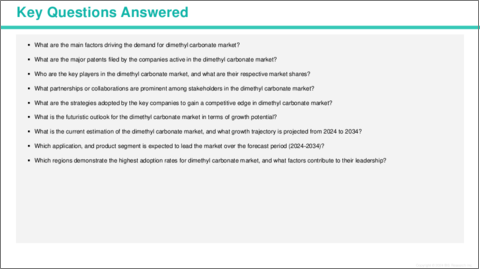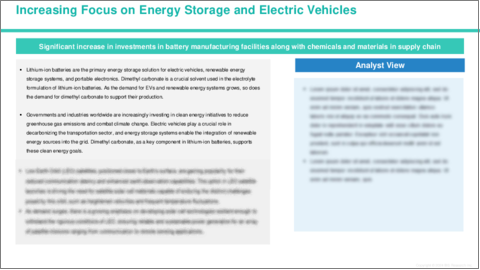|
|
市場調査レポート
商品コード
1500189
炭酸ジメチル市場 - 世界および地域の分析:用途・エンドユーザー産業・グレード・地域別の分析・予測 (2024-2034年)Dimethyl Carbonate Market - A Global and Regional Analysis: Focus on Application, End-use Industry, Grade, and Region - Analysis and Forecast, 2024-2034 |
||||||
カスタマイズ可能
|
|||||||
| 炭酸ジメチル市場 - 世界および地域の分析:用途・エンドユーザー産業・グレード・地域別の分析・予測 (2024-2034年) |
|
出版日: 2024年06月25日
発行: BIS Research
ページ情報: 英文 100 Pages
納期: 1~5営業日
|
全表示
- 概要
- 目次
世界の炭酸ジメチルの市場規模は、楽観的シナリオでは、2024年の12億8,000万米ドルから、CAGR 11.39%で推移し、2034年には37億6,000万米ドルに達すると予想されています。
炭酸ジメチル市場は、環境に優しい化学品への需要の高まりと、幅広い用途でのプラスチック需要の増加に後押しされ、大きな成長を遂げています。
| 主要市場統計 | |
|---|---|
| 予測期間 | 2024-2034年 |
| 2024年評価 | 12億8,000万米ドル |
| 2034年予測 | 37億6,000万米ドル |
| CAGR | 11.39% |
こうした市場促進要因にもかかわらず、市場は原料価格の変動などの課題に直面しています。しかし、主要産業における用途の拡大が、炭酸ジメチル需要の拡大に有利な機会をもたらし、合成における有毒化学物質の使用に対する課題を克服しながら、この市場の活気ある将来を示唆しています。
アジア太平洋地域は世界の製造業の大部分を担っています。同地域の製造部門は、化学、プラスチック、塗料、電子機器など幅広い産業に及んでおり、いずれも炭酸ジメチルの主要な消費者です。製造基盤の拡大が、工業プロセスや製品配合における炭酸ジメチルの需要を牽引しています。アジア太平洋地域では、自動車製造、電子機器製造、建設、製薬など、炭酸ジメチルを利用するエンドユーザー産業が力強い成長を遂げています。これらの産業が人口の増加と消費者所得の増加による需要に応えるために拡大するにつれて、主要な化学中間体および溶剤としての炭酸ジメチルに対する需要も相応に増加すると予想されています。
世界の政府と産業界は、温室効果ガスの排出を削減し、気候変動に対処するために、クリーンエネルギーへの投資を増やしています。電気自動車は輸送部門の脱炭素化に重要な役割を果たし、エネルギー貯蔵システムは再生可能エネルギー源の送電網への統合を可能にします。炭酸ジメチルは、リチウムイオン電池の主要成分として、こうしたクリーンエネルギーの目標を支えています。
当レポートでは、世界の炭酸ジメチルの市場を調査し、業界の動向、技術・特許の動向、法規制環境、ケーススタディ、市場成長促進要因・抑制要因、市場規模の推移・予測、各種区分・地域/主要国別の詳細分析、競合情勢、主要企業のプロファイルなどをまとめています。
目次
エグゼクティブサマリー
第1章 市場:業界の展望
- 動向:現在および将来の影響評価
- サプライチェーンの概要
- バリューチェーン分析
- 価格予測
- R&Dレビュー
- 特許出願動向:国・企業別
- 規制状況
- ステークホルダー分析
- 使用事例
- エンドユーザーと購入基準
- 主要な世界的イベントの影響分析
- 市場力学の概要
- 市場促進要因
- 市場抑制要因
- 市場機会
第2章 炭酸ジメチル市場:用途別
- 用途の分類
- 用途の概要
- 炭酸ジメチル市場:用途別
- ポリカーボネート合成
- バッテリー電解液
- 溶剤
- 試薬
- その他
- 炭酸ジメチル市場:エンドユーザー産業別
- プラスチック
- 塗料・コーティング
- 製薬
- 電池
- 農薬
- その他
第3章 炭酸ジメチル市場:製品別
- 製品の分類
- 製品の概要
- 炭酸ジメチル市場:グレード別
- 工業グレード
- 医薬品グレード
- バッテリーグレード
第4章 炭酸ジメチル市場:地域別
- 炭酸ジメチル市場:地域別
- 北米
- 欧州
- アジア太平洋
- その他の地域
第5章 企業プロファイル
- 次なるフロンティア
- 地理的評価
- UBE Corporation
- LOTTE Chemical Corporation
- Tokyo Chemical Industry Co., Ltd.
- KOWA AMERICAN CORPORATION
- Kishida Chemical Co., Ltd.
- Shandong Haike Chemical Group
- BASF SE
- Chaoyang Chemicals, Inc.
- Haihang Industry
- Shandong Shida Shenghua Chemical Group Co., Ltd.
- Merck KGaA
- Thermo Fisher Scientific Inc.
- Shandong Wells Chemicals Co., Ltd.
- Shandong Longze Chemical Co.,Ltd.
- Tongling Jintai Chemical Industrial Co., Ltd.
- その他の主要企業
第6章 調査手法
Introduction to Dimethyl Carbonate Market
Dimethyl carbonate market is experiencing significant growth, propelled by growing demand for environmentally friendly chemicals, and increasing demand for plastics in wide range of applications. Considering the optimistic scenario the market is valued at $1.28 billion in 2024 and is expected to grow at a CAGR of 11.39% to reach $3.76 billion by 2034.
| KEY MARKET STATISTICS | |
|---|---|
| Forecast Period | 2024 - 2034 |
| 2024 Evaluation | $1.28 Billion |
| 2034 Forecast | $3.76 Billion |
| CAGR | 11.39% |
Despite these positive drivers, the market faces hurdles such as volatility in raw material prices. However, expanding applications in key industries, present lucrative opportunities for the expansion of dimethyl carbonate demand, suggesting a vibrant future for this market as it navigates through challenges towards use of toxic chemicals in synthesis.
Asia-Pacific is home to a significant portion of the world's manufacturing activities. The region's manufacturing sector spans a wide range of industries, including chemicals, plastics, coatings, and electronics, all of which are key consumers of dimethyl carbonate. The growing manufacturing base drives the demand for dimethyl carbonate in industrial processes and product formulations. The Asia-Pacific region is witnessing robust growth in end-use industries that utilize dimethyl carbonate, such as automotive manufacturing, electronics production, construction, and pharmaceuticals. As these industries expand to meet the demands of growing populations and rising consumer incomes, the demand for dimethyl carbonate as a key chemical intermediate and solvent is expected to rise correspondingly. China has significant production capacity for dimethyl carbonate, with numerous domestic manufacturers operating in the country. These manufacturers benefit from access to abundant raw materials, skilled labor, and favorable government policies, enabling them to produce dimethyl carbonate at competitive prices. China's robust industrial growth and expanding manufacturing sector drive the demand for dimethyl carbonate in various applications. Industries such as automotive, electronics, pharmaceuticals, and coatings rely on dimethyl carbonate for its versatile properties, contributing to its increasing demand in the country.
Governments and industries worldwide are increasingly investing in clean energy initiatives to reduce greenhouse gas emissions and combat climate change. Electric vehicles play a crucial role in decarbonizing the transportation sector, and energy storage systems enable the integration of renewable energy sources into the grid. Dimethyl carbonate, as a key component in lithium-ion batteries, supports these clean energy goals. For instance, in February 2022, LOTTE Chemical Corporation unveiled plans to construct a new facility dedicated to the production of high-purity solvents for battery electrolytes. The company is erecting this new plant for the manufacturing of ethylene carbonate and dimethyl carbonate at its production site located in Daesan, approximately 75 kilometers southwest of Seoul. LOTTE Chemical is committing an investment of $502 million toward its environmentally sustainable and cutting-edge materials business. Lithium-ion batteries are the primary energy storage solution for electric vehicles, renewable energy storage systems, and portable electronics. Dimethyl carbonate is a crucial solvent used in the electrolyte formulation of lithium-ion batteries. As the demand for EVs and renewable energy systems grows, so does the demand for dimethyl carbonate to support their production.
Market Segmentation:
Segmentation 1: by Application
- Polycarbonate Synthesis
- Battery Electrolyte
- Solvents
- Reagents
- Others
Segmentation 2: by End-use Indsutry
- Plastics
- Paints and Coatings
- Pharmaceutical
- Battery
- Agrochemicals
- Others
Segmentation 3: by Grade
- Industrial Grade
- Pharmaceutical Grade
- Battery Grade
Segmentation 4: by Region
- North America
- Europe
- Asia-Pacific
- Rest-of-the-World
How can this report add value to an organization?
Product/Innovation Strategy: The global dimethyl carbonate market has been extensively segmented based on various categories, such as application, grade, and end-use indsutry. This can help readers get a clear overview of which segments account for the largest share and which ones are well-positioned to grow in the coming years.
Competitive Strategy: A detailed competitive benchmarking of the players operating in the global dimethyl carbonate market has been done to help the reader understand how players stack against each other, presenting a clear market landscape. Additionally, comprehensive competitive strategies such as partnerships, agreements, and collaborations will aid the reader in understanding the untapped revenue pockets in the market.
Key Market Players and Competition Synopsis
The companies that are profiled have been selected based on thorough secondary research, which includes analyzing company coverage, product portfolio, market penetration, and insights gathered from primary experts.
Some of the prominent companies in this market are:
- UBE Corporation
- LOTTE Chemical Corporation
- Tokyo Chemical Industry Co., Ltd.
- Kishida Chemical Co., Ltd.
- Merck KGaA
Key Questions Answered in this Report:
- What are the main factors driving the demand for dimethyl carbonate market?
- What are the major patents filed by the companies active in the dimethyl carbonate market?
- Who are the key players in the dimethyl carbonate market, and what are their respective market shares?
- What partnerships or collaborations are prominent among stakeholders in the dimethyl carbonate market?
- What are the strategies adopted by the key companies to gain a competitive edge in dimethyl carbonate market?
- What is the futuristic outlook for the dimethyl carbonate market in terms of growth potential?
- What is the current estimation of the dimethyl carbonate market, and what growth trajectory is projected from 2024 to 2034?
- Which application, and product segment is expected to lead the market over the forecast period (2024-2034)?
- Which regions demonstrate the highest adoption rates for dimethyl carbonate market, and what factors contribute to their leadership?
Table of Contents
Executive Summary
Scope and Definition
Market/Product Definition
Key Questions Answered
Analysis and Forecast Note
1. Markets: Industry Outlook
- 1.1 Trends: Current and Future Impact Assessment
- 1.2 Supply Chain Overview
- 1.2.1 Value Chain Analysis
- 1.2.2 Pricing Forecast
- 1.3 R&D Review
- 1.3.1 Patent Filing Trend by Country, by Company
- 1.4 Regulatory Landscape
- 1.5 Stakeholder Analysis
- 1.5.1 Use Case
- 1.5.2 End User and Buying Criteria
- 1.6 Impact Analysis for Key Global Events
- 1.7 Market Dynamics Overview
- 1.7.1 Market Drivers
- 1.7.2 Market Restraints
- 1.7.3 Market Opportunities
2. Dimethyl Carbonate Market (by Application)
- 2.1 Application Segmentation
- 2.2 Application Summary
- 2.3 Dimethyl Carbonate Market (by Application)
- 2.3.1 Polycarbonate Synthesis
- 2.3.2 Battery Electrolyte
- 2.3.3 Solvents
- 2.3.4 Reagents
- 2.3.5 Others
- 2.4 Dimethyl Carbonate Market (by End-use Industry)
- 2.4.1 Plastics
- 2.4.2 Paints and Coatings
- 2.4.3 Pharmaceutical
- 2.4.4 Battery
- 2.4.5 Agrochemicals
- 2.4.6 Others
3. Dimethyl Carbonate Market (by Product)
- 3.1 Product Segmentation
- 3.2 Product Summary
- 3.3 Dimethyl Carbonate Market (by Grade)
- 3.3.1 Industrial Grade
- 3.3.2 Pharmaceutical Grade
- 3.3.3 Battery Grade
4. Dimethyl Carbonate Market (by Region)
- 4.1 Dimethyl Carbonate Market (by Region)
- 4.2 North America
- 4.2.1 Regional Overview
- 4.2.2 Driving Factors for Market Growth
- 4.2.3 Factors Challenging the Market
- 4.2.4 Application
- 4.2.5 Product
- 4.2.6 U.S.
- 4.2.6.1 Market by Application
- 4.2.6.2 Market by Product
- 4.2.7 Canada
- 4.2.7.1 Market by Application
- 4.2.7.2 Market by Product
- 4.2.8 Mexico
- 4.2.8.1 Market by Application
- 4.2.8.2 Market by Product
- 4.3 Europe
- 4.3.1 Regional Overview
- 4.3.2 Driving Factors for Market Growth
- 4.3.3 Factors Challenging the Market
- 4.3.4 Application
- 4.3.5 Product
- 4.3.6 Germany
- 4.3.6.1 Market by Application
- 4.3.6.2 Market by Product
- 4.3.7 France
- 4.3.7.1 Market by Application
- 4.3.7.2 Market by Product
- 4.3.8 U.K.
- 4.3.8.1 Market by Application
- 4.3.8.2 Market by Product
- 4.3.9 Italy
- 4.3.9.1 Market by Application
- 4.3.9.2 Market by Product
- 4.3.10 Rest-of-Europe
- 4.3.10.1 Market by Application
- 4.3.10.2 Market by Product
- 4.4 Asia-Pacific
- 4.4.1 Regional Overview
- 4.4.2 Driving Factors for Market Growth
- 4.4.3 Factors Challenging the Market
- 4.4.4 Application
- 4.4.5 Product
- 4.4.6 China
- 4.4.6.1 Market by Application
- 4.4.6.2 Market by Product
- 4.4.7 Japan
- 4.4.7.1 Market by Application
- 4.4.7.2 Market by Product
- 4.4.8 India
- 4.4.8.1 Market by Application
- 4.4.8.2 Market by Product
- 4.4.9 South Korea
- 4.4.9.1 Market by Application
- 4.4.9.2 Market by Product
- 4.4.10 Rest-of-Asia-Pacific
- 4.4.10.1 Market by Application
- 4.4.10.2 Market by Product
- 4.5 Rest-of-the-World
- 4.5.1 Regional Overview
- 4.5.2 Driving Factors for Market Growth
- 4.5.3 Factors Challenging the Market
- 4.5.4 Application
- 4.5.5 Product
- 4.5.6 South America
- 4.5.6.1 Market by Application
- 4.5.6.2 Market by Product
- 4.5.7 Middle East and Africa
- 4.5.7.1 Market by Application
- 4.5.7.2 Market by Product
5. Companies Profiled
- 5.1 Next Frontiers
- 5.2 Geographic Assessment
- 5.2.1 UBE Corporation
- 5.2.1.1 Overview
- 5.2.1.2 Top Products/Product Portfolio
- 5.2.1.3 Top Competitors
- 5.2.1.4 Target Customers
- 5.2.1.5 Key Personnel
- 5.2.1.6 Analyst View
- 5.2.1.7 Market Share
- 5.2.2 LOTTE Chemical Corporation
- 5.2.2.1 Overview
- 5.2.2.2 Top Products/Product Portfolio
- 5.2.2.3 Top Competitors
- 5.2.2.4 Target Customers
- 5.2.2.5 Key Personnel
- 5.2.2.6 Analyst View
- 5.2.2.7 Market Share
- 5.2.3 Tokyo Chemical Industry Co., Ltd.
- 5.2.3.1 Overview
- 5.2.3.2 Top Products/Product Portfolio
- 5.2.3.3 Top Competitors
- 5.2.3.4 Target Customers
- 5.2.3.5 Key Personnel
- 5.2.3.6 Analyst View
- 5.2.3.7 Market Share
- 5.2.4 KOWA AMERICAN CORPORATION
- 5.2.4.1 Overview
- 5.2.4.2 Top Products/Product Portfolio
- 5.2.4.3 Top Competitors
- 5.2.4.4 Target Customers
- 5.2.4.5 Key Personnel
- 5.2.4.6 Analyst View
- 5.2.4.7 Market Share
- 5.2.5 Kishida Chemical Co., Ltd.
- 5.2.5.1 Overview
- 5.2.5.2 Top Products/Product Portfolio
- 5.2.5.3 Top Competitors
- 5.2.5.4 Target Customers
- 5.2.5.5 Key Personnel
- 5.2.5.6 Analyst View
- 5.2.5.7 Market Share
- 5.2.6 Shandong Haike Chemical Group
- 5.2.6.1 Overview
- 5.2.6.2 Top Products/Product Portfolio
- 5.2.6.3 Top Competitors
- 5.2.6.4 Target Customers
- 5.2.6.5 Key Personnel
- 5.2.6.6 Analyst View
- 5.2.6.7 Market Share
- 5.2.7 BASF SE
- 5.2.7.1 Overview
- 5.2.7.2 Top Products/Product Portfolio
- 5.2.7.3 Top Competitors
- 5.2.7.4 Target Customers
- 5.2.7.5 Key Personnel
- 5.2.7.6 Analyst View
- 5.2.7.7 Market Share
- 5.2.8 Chaoyang Chemicals, Inc.
- 5.2.8.1 Overview
- 5.2.8.2 Top Products/Product Portfolio
- 5.2.8.3 Top Competitors
- 5.2.8.4 Target Customers
- 5.2.8.5 Key Personnel
- 5.2.8.6 Analyst View
- 5.2.8.7 Market Share
- 5.2.9 Haihang Industry
- 5.2.9.1 Overview
- 5.2.9.2 Top Products/Product Portfolio
- 5.2.9.3 Top Competitors
- 5.2.9.4 Target Customers
- 5.2.9.5 Key Personnel
- 5.2.9.6 Analyst View
- 5.2.9.7 Market Share
- 5.2.10 Shandong Shida Shenghua Chemical Group Co., Ltd.
- 5.2.10.1 Overview
- 5.2.10.2 Top Products/Product Portfolio
- 5.2.10.3 Top Competitors
- 5.2.10.4 Target Customers
- 5.2.10.5 Key Personnel
- 5.2.10.6 Analyst View
- 5.2.10.7 Market Share
- 5.2.11 Merck KGaA
- 5.2.11.1 Overview
- 5.2.11.2 Top Products/Product Portfolio
- 5.2.11.3 Top Competitors
- 5.2.11.4 Target Customers
- 5.2.11.5 Key Personnel
- 5.2.11.6 Analyst View
- 5.2.11.7 Market Share
- 5.2.12 Thermo Fisher Scientific Inc.
- 5.2.12.1 Overview
- 5.2.12.2 Top Products/Product Portfolio
- 5.2.12.3 Top Competitors
- 5.2.12.4 Target Customers
- 5.2.12.5 Key Personnel
- 5.2.12.6 Analyst View
- 5.2.12.7 Market Share
- 5.2.13 Shandong Wells Chemicals Co., Ltd.
- 5.2.13.1 Overview
- 5.2.13.2 Top Products/Product Portfolio
- 5.2.13.3 Top Competitors
- 5.2.13.4 Target Customers
- 5.2.13.5 Key Personnel
- 5.2.13.6 Analyst View
- 5.2.13.7 Market Share
- 5.2.14 Shandong Longze Chemical Co.,Ltd.
- 5.2.14.1 Overview
- 5.2.14.2 Top Products/Product Portfolio
- 5.2.14.3 Top Competitors
- 5.2.14.4 Target Customers
- 5.2.14.5 Key Personnel
- 5.2.14.6 Analyst View
- 5.2.14.7 Market Share
- 5.2.15 Tongling Jintai Chemical Industrial Co., Ltd.
- 5.2.15.1 Overview
- 5.2.15.2 Top Products/Product Portfolio
- 5.2.15.3 Top Competitors
- 5.2.15.4 Target Customers
- 5.2.15.5 Key Personnel
- 5.2.15.6 Analyst View
- 5.2.15.7 Market Share
- 5.2.16 Other Key Players
- 5.2.1 UBE Corporation





